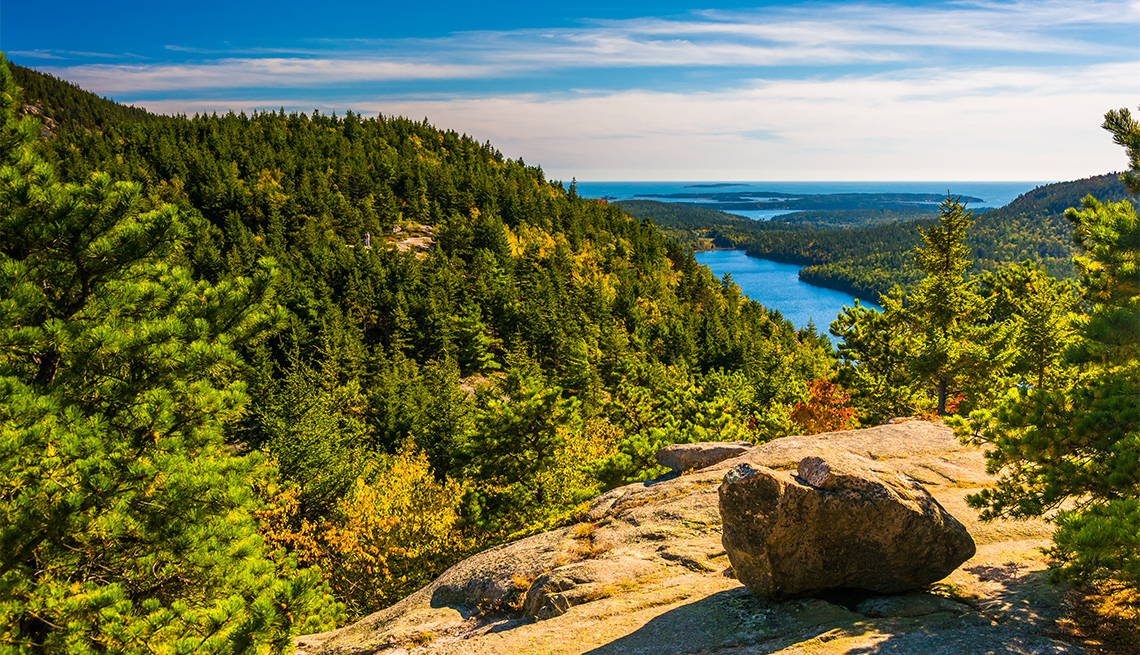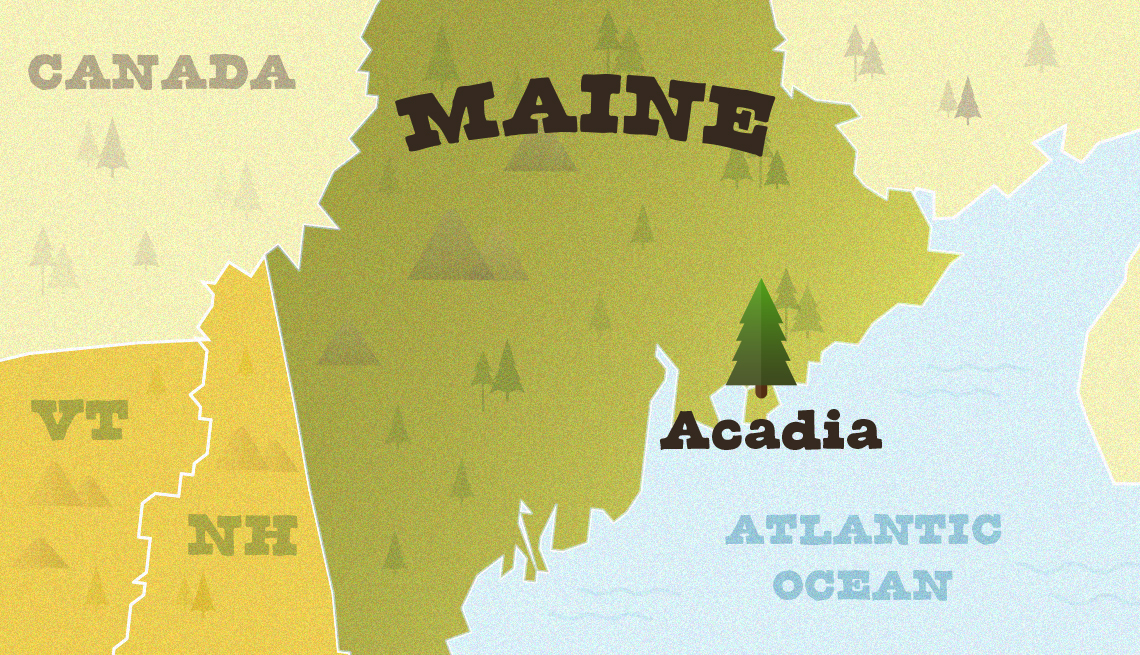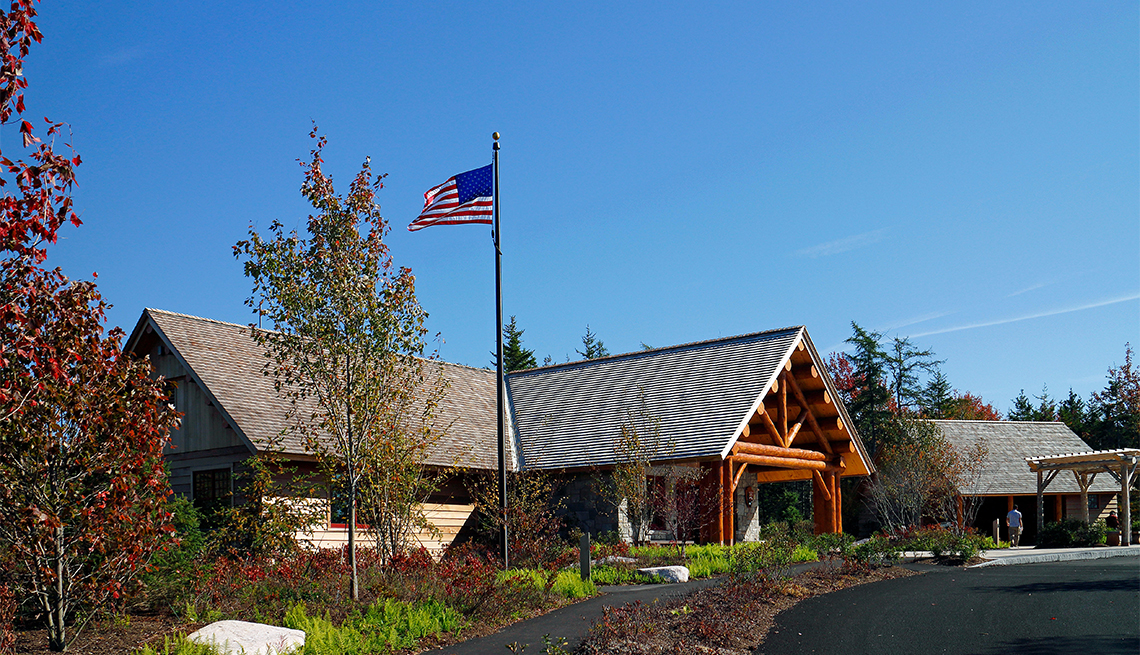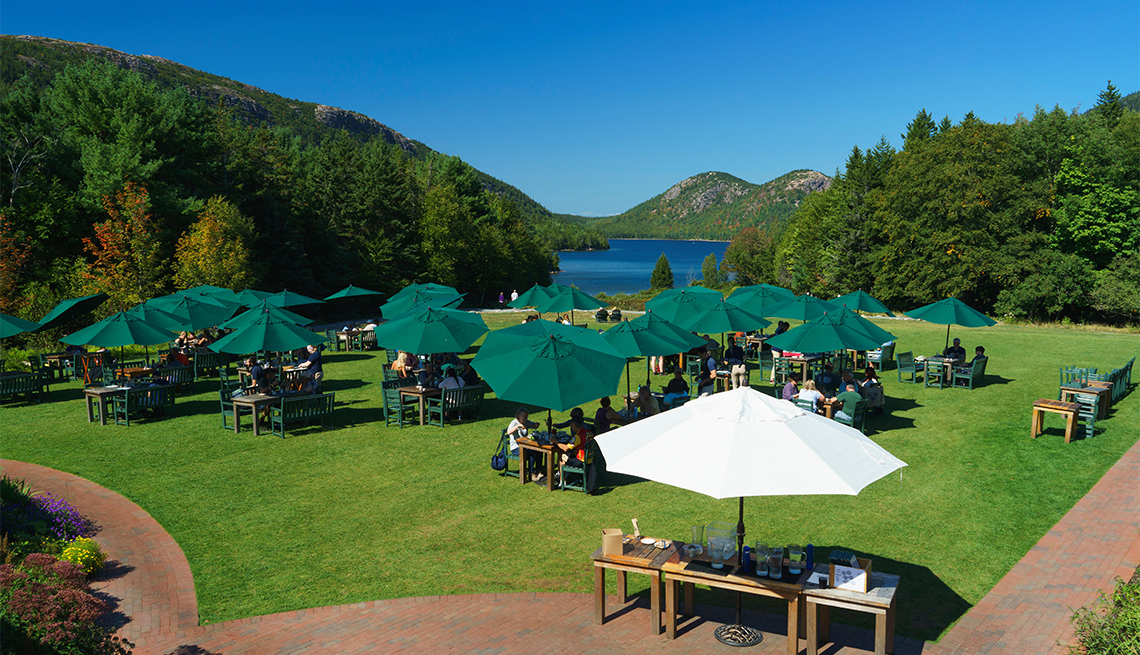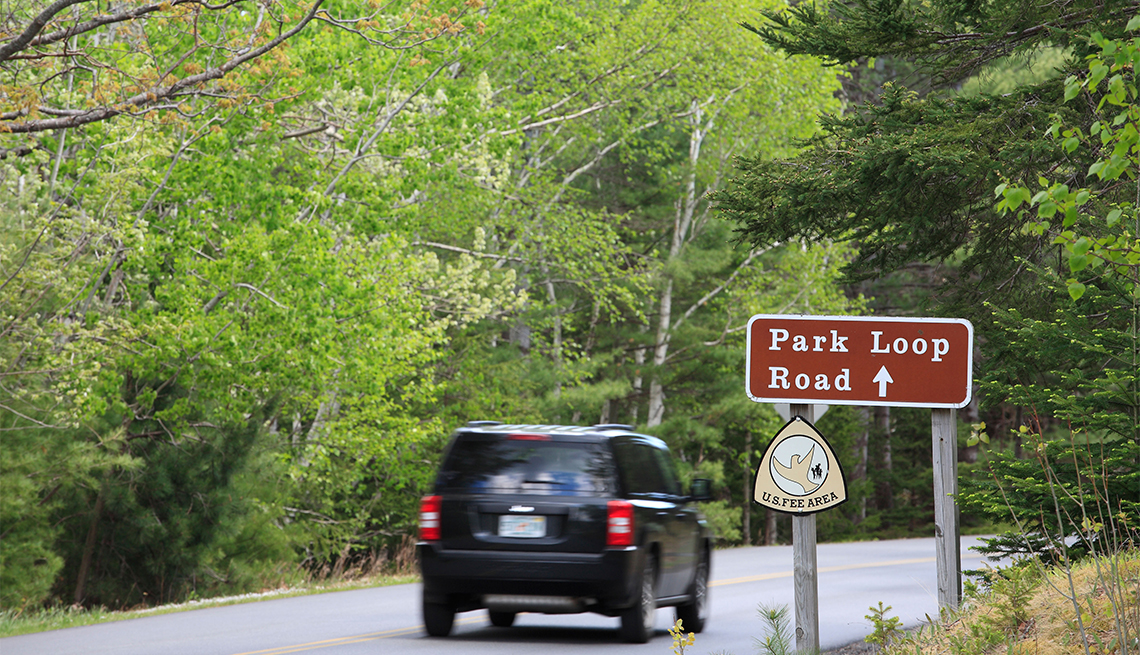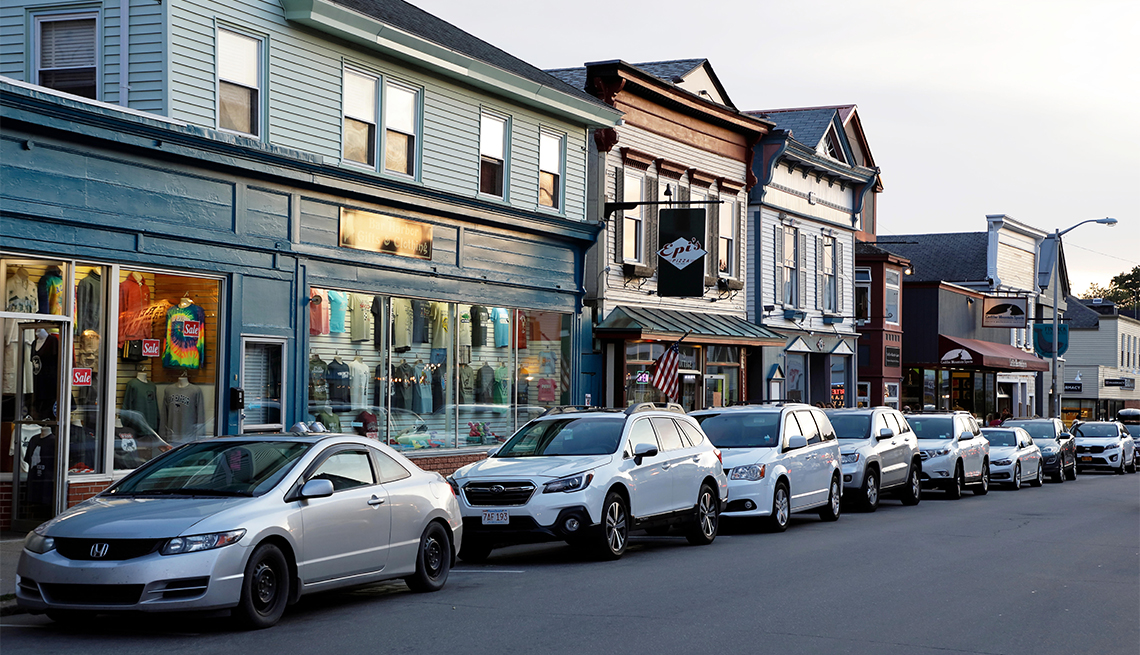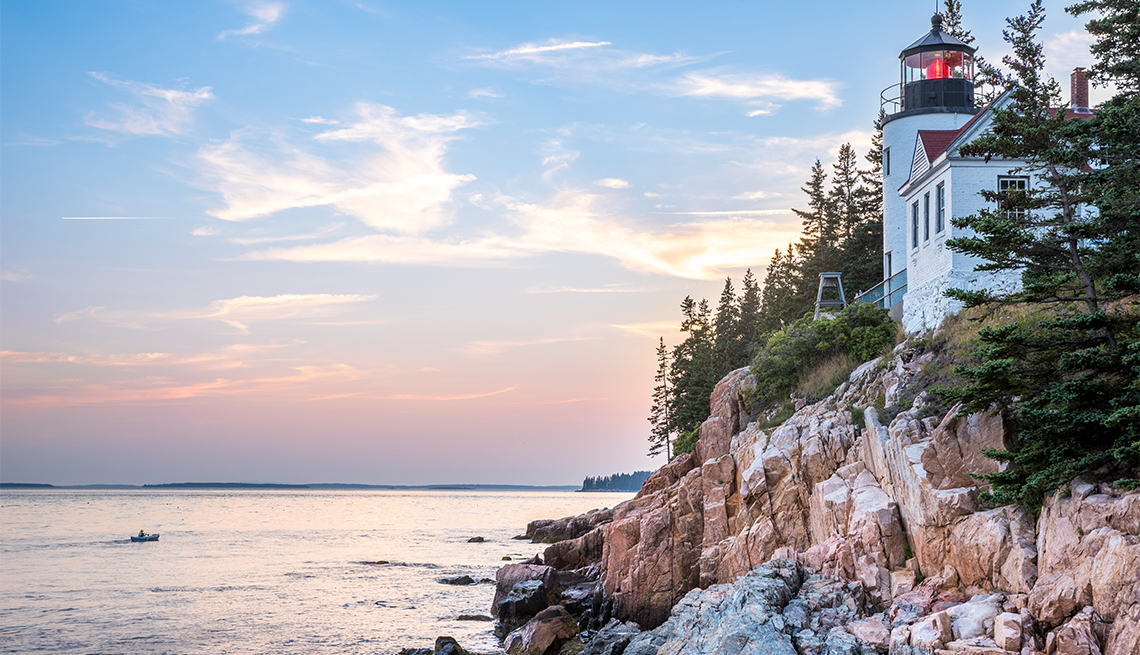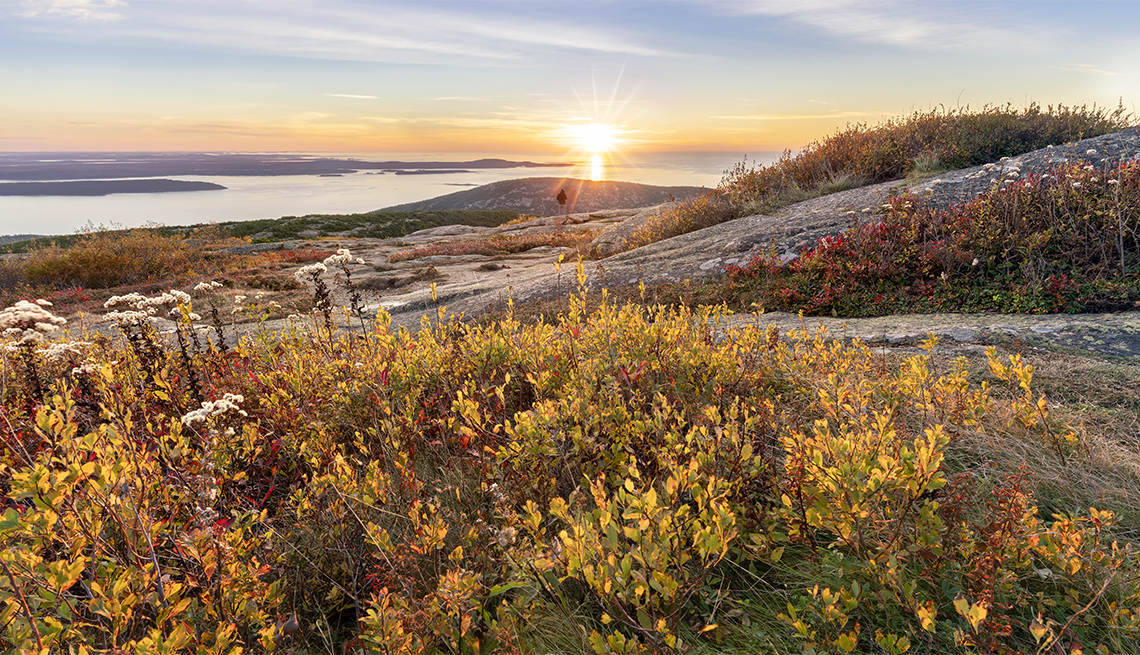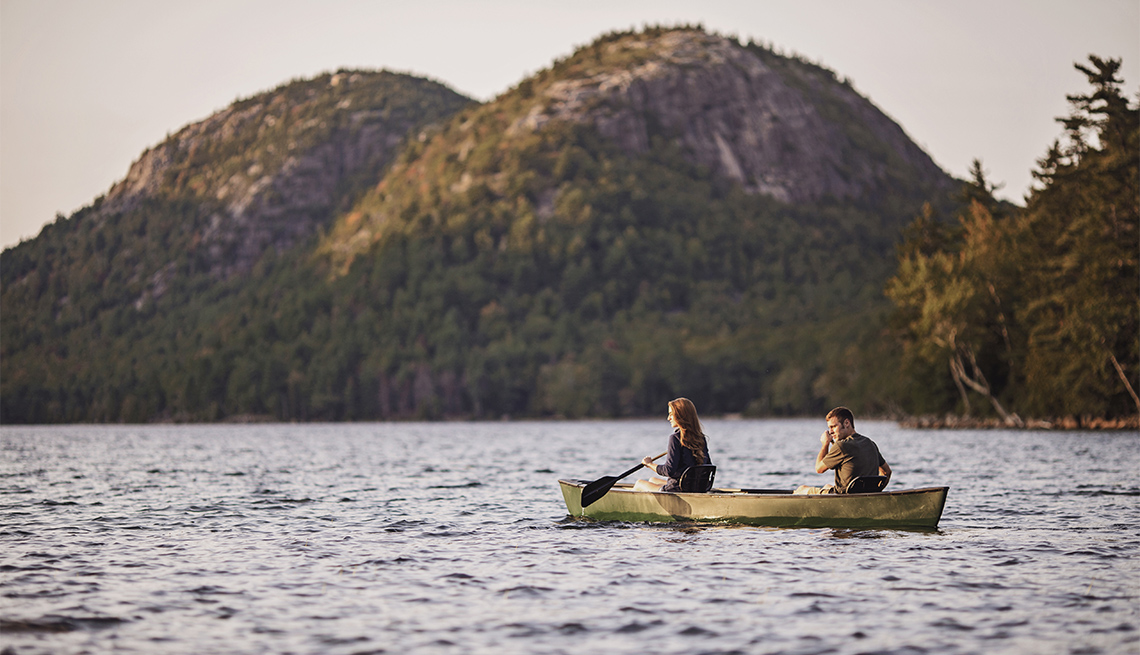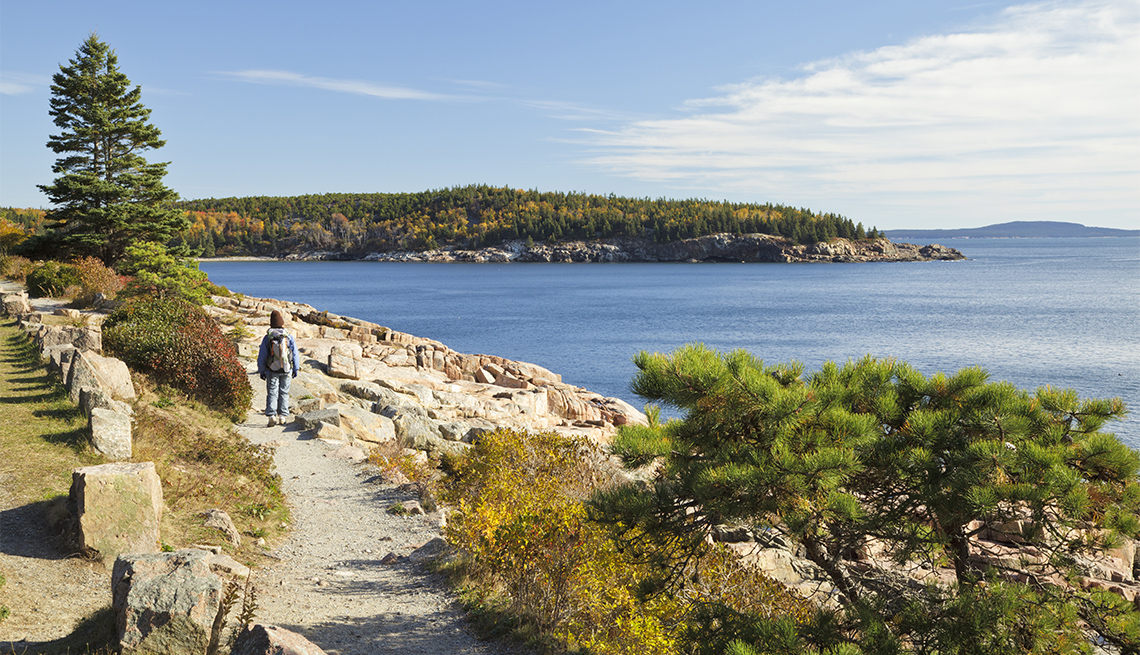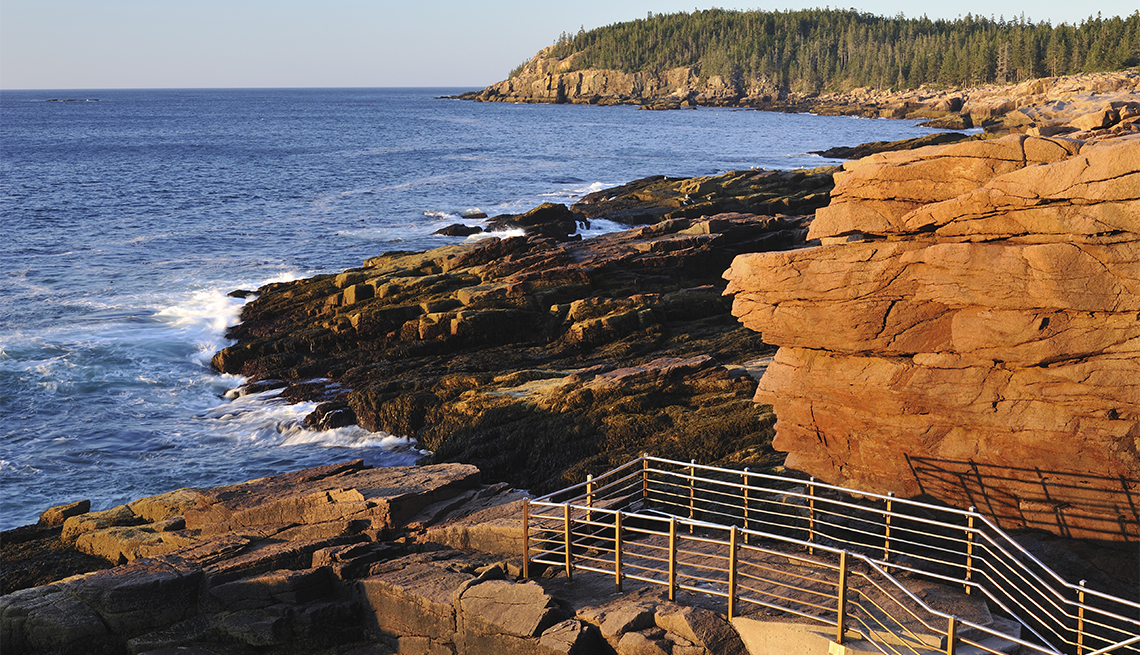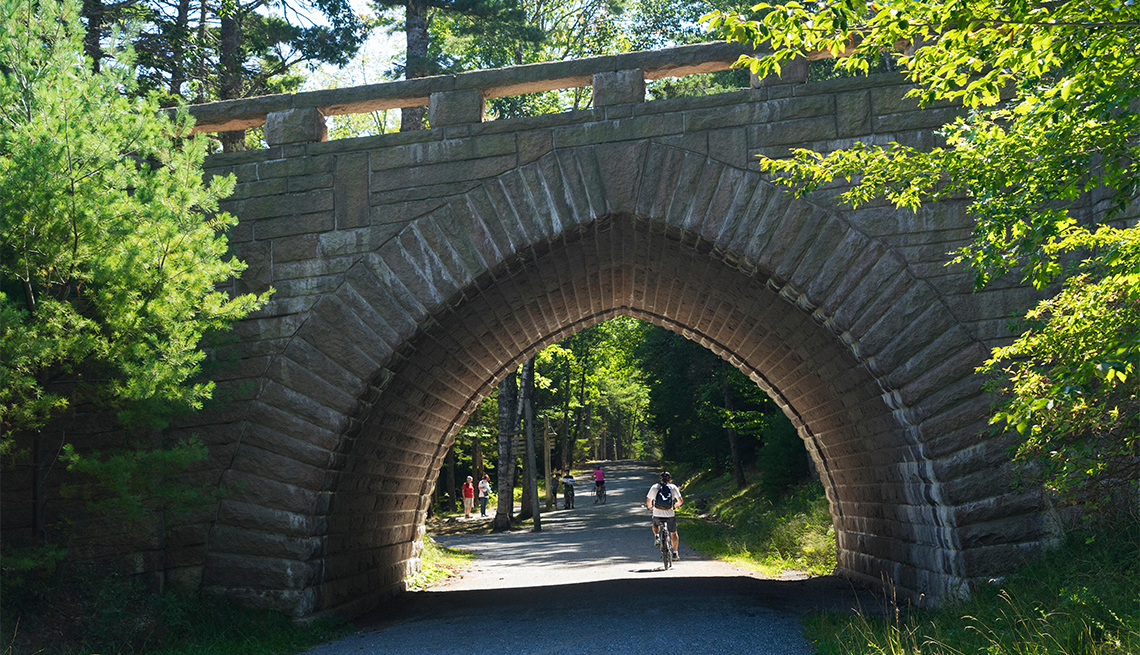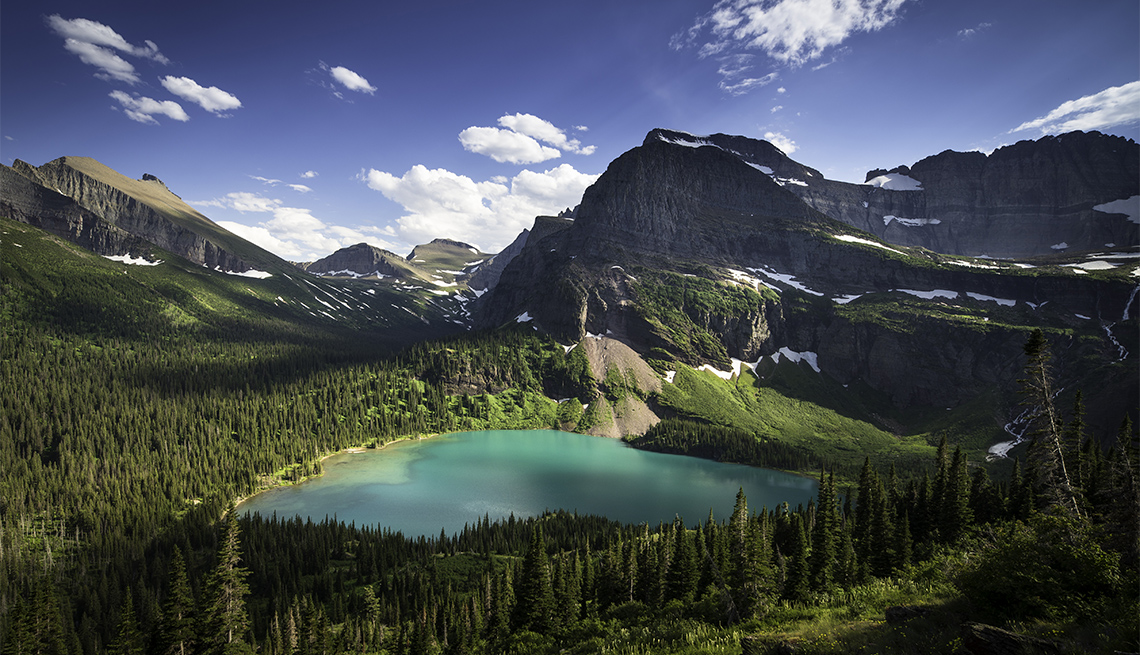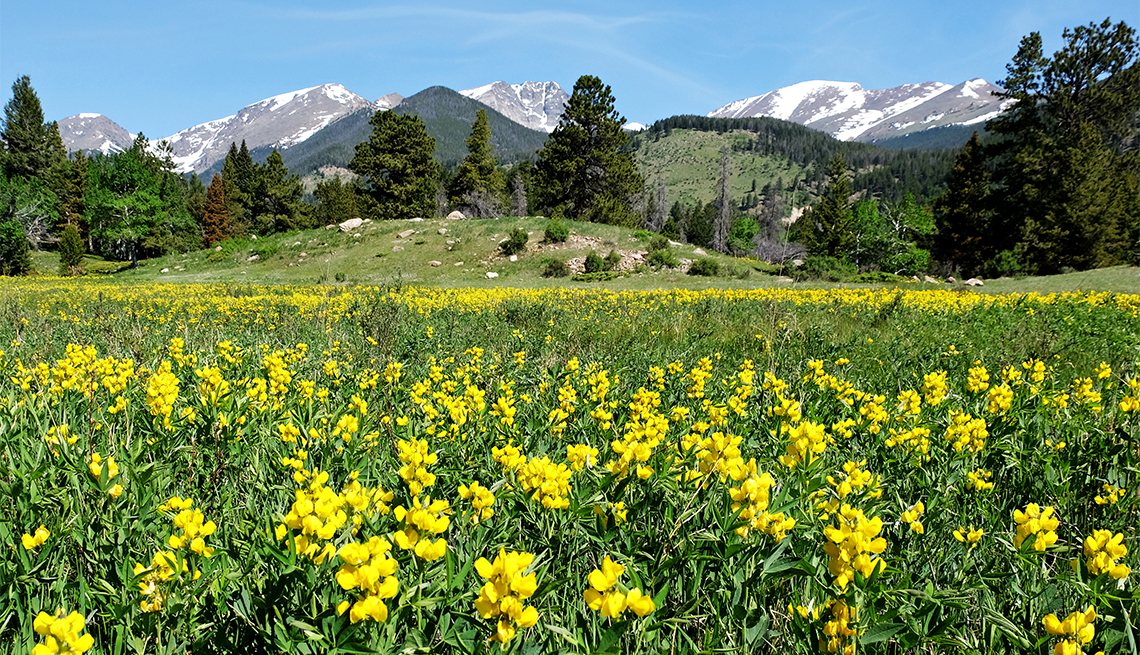AARP's Guide to Acadia National Park
Spectacular ocean views and cool forest trails along the rocky coast of Maine
En español | Surf crashing on craggy granite shores, sun rising over glacier-scrubbed mountain peaks, shimmering lakes and ponds, and 126 miles of trails throughout seductive woodlands: All contribute to Acadia National Park's status as one of America's favorites; it welcomed 4 million visitors in 2019.
Spread out over 36,968 acres along Maine's down east coast, Acadia's is both a natural and cultural treasure, with human constructed wonders — including beautiful carriage roads — created to complement nature's gifts.
Named Lafayette National Park in 1919, then renamed Acadia National Park a decade later, the park was created from privately owned parcels donated by local residents and wealthy summer visitors. Those summer folk included some of the Northeast's richest families, with names like Rockefeller, who built grand homes quaintly called cottages. Others came to stay at equally grand hotels in Bar Harbor, Northeast Harbor and Southwest Harbor. Concerned about the increasing development, summer resident George Dorr began soliciting donations of land and money to help preserve the island's landscape in 1901.
This piecemeal approach explains the park's crazy-quilt borders, which edge backyards and villages, with occasional in-town patches. It encompasses more than half of Mount Desert Island, the causeway-and-bridge-connected island that's home to the town of Bar Harbor, as well as smaller islands and part of the mainland Schoodic Peninsula.
While the terrain is rugged, there are plenty of ways for those with limited mobility to enjoy the natural beauty and spectacular views here. One of the most popular things to do at Acadia, in fact, is to walk or drive segments of the 27-mile Park Loop Road. It noodles through woodlands, along the granite-lined coast, and up 1,530-foot Cadillac Mountain — the first place on the East Coast to see the sun's rays each morning. There are also easy-to-navigate crushed-gravel trails and 45 miles of carriage roads.
"It's a very accessible park,” says Christie Anastasia, Acadia's public affairs specialist. “And if you do travel here with multiple people, there's something for everyone — it's easy to split up and do different things and then reconvene.”
Location: Mount Desert Island, Maine, with smaller parcels on the Schoodic Peninsula, Isle au Haut and other islands
Website: nps.gov/acadia
Phone: 207-288-3338
Total acres: 36,968
Miles of trails: more than 125 miles
Main attractions: Park Loop Road, with spur to Cadillac Mountain's summit; carriage roads
Cost: $30 per vehicle for a seven-day pass (Annual Senior Pass $20)
Reservations: The park has a timed-entry reservation system for private vehicles in the Cadillac Summit Road sections of Park Loop Road ($6 fee charged). Make reservations for campgrounds online.
Best way to see it: on bicycle or on foot
When to go to avoid crowds: The shoulder seasons — spring, and September and October
Plan Your Trip
Acadia is about a five-hour drive from Boston, where you can fly in and rent a car to begin a scenic road trip north (be sure to stop in Portland and Camden). Or choose a closer airport: Trenton, 12 miles northwest of Bar Harbor, has direct flights from Boston, and the Island Explorer bus service connects the airport with the park and island towns. More airlines fly into Bangor, about 50 miles northwest of the park, and Portland, about 160 miles southwest (about 3 1/2 hours driving time). Concord Coach Lines provides bus service between Bangor, Boston and Portland; Downeast Transportation and the Bar Harbor-Bangor Shuttle connect Bangor with Bar Harbor.
A seven-day pass ($30, $20 with a senior pass for ages 62-plus) covers entrance to all of Acadia's sections and gives you free rides on the Island Explorer, with eight routes connecting all major towns and most park sights and trailheads on Mount Desert Island. Another route serves the Schoodic area and connects with a commercial passenger ferry from Bar Harbor. The buses operate late June through mid-October.
During peak season, mid-June through mid-October, most park facilities are open, as are accommodations, restaurants and sites in nearby towns. Mainers refer to spring — when winter snow and ice are melting and April showers may be snow — as mud season, so Mother Nature determines when park and town facilities and services begin to open. Fall foliage usually begins turning by early October. November through mid-May is Acadia's quiet season, with no facilities open and few area options for lodging or dining.
Acadia doesn't have a main entry point; if you want to drive the Park Loop Road, arrive through the Sand Beach Entrance Station at the eastern edge of the park.
You can find a handful of information centers around Mount Desert Island, but there's only one Visitor Center, at Hull's Cove at the northern tip of the park. The info and visitor centers, Jordan Pond House, and most picnic areas have modern restrooms; vault toilets can be found at many sites along Park Loop Road as well as at some trailheads and at the Pretty Marsh Picnic Area. Bar Harbor, Northeast Harbor and Southwest Harbor have public restrooms. Cell service in Acadia is improving but, depending upon your carrier, it may be spotty in places.
Where to Stay
You won't be pampered if you stay in the park, which has no hotels, but you will get a good dose of nature by camping at one of its four campgrounds ($20 to $40 per night; reservations required, through recreation.gov), all a short walk from the water. On Mount Desert Island's eastern side, Blackwoods has 281 sites; on the western side, Seawall has 291. Neither provide RV hookups.
Schoodic Woods, in the park's Schoodic section, has 89 sites; all but hike-in sites offer electricity, B-Loop sites also offer water. All three campgrounds have flush toilets, running water and a dump station, and all allow leashed pets. Each site includes a picnic table and fire ring. Nearby towns offer coin-op showers.
The primitive Duck Harbor Campground, on remote Isle au Haut, has only five sites, each with lean-to, picnic table, fire ring and food locker. A hand pump, about 0.03 mile from the sites, supplies drinking water.
For Bar Harbor lodging, experience the grandeur of the town's gilded age at the Saltair Inn, a waterfront bed-and-breakfast dating from 1887, or go easier on the budget at the Edenbrook Motel, a family-owned, newly renovated property with four buildings tiered up a hillside.
You'll find plenty more accommodations in other island towns including Mount Desert, Northeast Harbor and Southwest Harbor, or just over the causeway in Trenton. Some private campgrounds also offer camping cabins and glamping tents.
Where to Eat
Make reservations in advance to dine at Jordan Pond House, on Park Loop Road. The park's only restaurant, it overlooks the Bubbles, two small but distinct mountains across the waters of Jordan Pond. It serves standard lunch and dinner fare, but go for afternoon tea, with popovers and strawberry jam, a park tradition. Opt for a table on the lawn.
Or break out a picnic in one of Acadia's six picnic areas, some nestled in the woods, other on or near water. You'll find five on Mount Desert Island (Bear Brook, near Sieur de Monts Springs; Fabbri, near Otter Point, on the Park Loop Road; Pretty Marsh and Seawall, both on the island's west side; and Thompson Island, just over the causeway from Trenton), and one in Schoodic, Frazer Point. All are just off a road, so they are easy to access and have at least one accessible site as well as restrooms.
Outside the park, plan lunch at Thurston's Lobster Pound, a classic Maine lobster shack hanging over Bass Harbor. As you feast on fresh-from-the-ocean lobster — either whole or in a lobster roll — watch lobster boats unload their catches.
There are also restaurants on Mount Desert Island that are within walking or pedaling distance of the park. Two good choices in Bar Harbor: Galyn's Galley has been satisfying diners since 1986 with its wide-ranging menu and early bird specials. For fine dining with a Latin accent, make reservations at Havana. Try its seafood paella cooked in saffron rice.
Things to Do
Sightsee by car. Any first-time visitor to Acadia should drive the mostly one-way, 27-mile Park Loop Road. You'll want to stop at most of the sights along the way, especially at these three standouts: Sand Beach, whose lovely pink hue comes from pulverized shells; Thunder Hole, named for the booming sound created when water rushes into this chasm one to two hours before high tide and during storms; and Cadillac Mountain. Although especially popular at sunrise and sunset — think crowds — the panoramic views from Cadillac's 1,530-foot glacier-scrubbed, pink granite peak earn raves anytime. You can drive up on Summit Road, though a reservation is required in the busiest months, April through October, with a $6 fee charged per vehicle.
Try another route by heading west from Bar Harbor to the middle of the park, then cruise south along Somes Sound, which cleaves Mount Desert Island nearly in two. Enjoy the views, then loop around and explore the island's quiet western side. Powerful ocean storms and tidal ebb and flow created Seawall, a massive natural stonewall. The coolest things here are the birds: Bring a scope or binoculars to spy seabirds, including bufflehead, sandpipers and perhaps a Leach's storm-petrel from the shore. Wander inland through the campground and along the Hio Road to the Big Heath to hear warblers and perhaps even a rare yellow-bellied flycatcher.
Also drive south to find Bass Harbor Head Light, an 1858 beacon that you might recognize from the 2012 America the Beautiful quarter. If you have good balance and sturdy footwear, follow the short path down to the rocky shoreline for the best photos.
Sightsee from the water. To truly appreciate the park's mountains-tumbling-to-the-shore landscape, see it from the ocean on a ranger-guided boating excursion. The 2.75-hour Acadia by Sea Nature Cruise delivers fabulous views not only of Mount Desert Island but also of the Schoodic Peninsula and two lighthouses. You'll likely spot birds of prey and harbor seals, while also learning about the region's natural and cultural heritage.
For a deeper dive, book the five-hour Baker Island Cruise to the 130-acre park-owned island, home to the 200-year-old Gilley family farmstead and the Baker Island Lighthouse. The ranger explains the family's history as well as its relationship with the lighthouse. Bring a picnic lunch to enjoy on the granite ledges at the tower's base.
Kayaking is another good option. Jordan Pond entices freshwater paddlers, though swimming is banned. Plan an early-morning visit to hear the songbirds greet the day and perhaps spy common yellowthroat and spotted sandpiper. Or book a guided sea-kayaking tour from a local outfitter, such as National Park Kayak Tours in Bar Harbor or Maine State Sea Kayak in Southwest Harbor.
Sightsee on foot. Combine the intimacy of Acadia's woods with the grandeur of its granite-girdled coast by hiking its more than 125 miles of trails. “There's such variety [of trails] that regardless of age or skill level, there's more than enough for folks. Trails run the gamut, from the Ocean Path's groomed crushed gravel to ladder trails up different mountains,” says Earl Brechlin, 66, author of Hiking Mount Desert Island, who has been hiking here for more than 40 years.
You can find the easy, 2.2-mile Ocean Path on Mount Desert Island's east side, which tends to be busier than on the west. It's a one-way trail tucked between Ocean Drive and the granite shoreline that offers fantastic water views. The carriage roads also appeal to those who prefer a nice walk rather than a more aggressive hike.
For more of a challenge, hike Great Head, a moderate 1.7-mile trail on the headland framing Sand Beach. Enjoy a picnic by the ruins of a former stone teahouse built in 1915 by J.P. Morgan's daughter. On a hot day, refresh with a swim at the beach — but be prepared: The water temperature rarely rises much above 60 degrees.
On the island's west side, the Ship Harbor Nature Path is an easy 1.3-mile figure-eight loop that moseys through a variety of habitats before emerging on the shoreline. Time it with a receding tide to explore tide pools left behind. The first loop is ADA compliant.
Gaze over the mouths of Somes Sound and both Northwest and Southwest Harbors from the 284-foot summit of Flying Mountain. The moderate 1.5-mile Flying Mountain loop descends to a rocky cove and returns by way of the flat Valley Cove Road, a service road threading through the woods.
Sightsee on bicycle. For easy-to-moderate mountain biking, explore Acadia's wide carriage roads, originally designed and graded for horses and carriages. The loops around Eagle Lake and Witch Hole Pond and the roads radiating from the Jordan Pond House and the Brown Mountain Gatehouse lead into the park's wooded interior. For challenging rides that take you deeper into the park, pedal the 5.5-mile Amphitheatre Loop or the 11-mile Around the Mountain loop. Both feature handsome granite bridges and waterfalls.
Sightsee by horse-drawn carriage. Pretend you're a visitor from bygone days and head to Wildwood Stables, off the Park Loop Road in Seal Harbor, for a horse-drawn carriage tour. These one- and two-hour rides are wheelchair accessible.
Explore a less-visited area of Acadia. Board the passengers-only Bar Harbor-Winter Harbor Ferry and explore the Schoodic section for a day. You'll get plenty of sightseeing on the 45-minute cruise as the boat weaves through islands. Be sure to head for Schoodic Point, where you can find a quiet spot on the pink granite ledges to watch waves crash and gaze westward to the rounded peaks of Mount Desert Island. Visit the Rockefeller Welcome Center on the Schoodic Institute campus for info about the local flora and fauna, as well as its history. Use the Island Explorer bus system to get around or bring a bike aboard the ferry.
Activities Outside the Park
Enjoy Bar Harbor. Mount Desert Island's anchor town bustles with activity thanks to plentiful lodging and dining options, outfitters offering sporting equipment rentals and guided excursions, the College of the Atlantic campus and a few attractions worth visiting. Two of those attractions: the Abbe Museum, a Smithsonian affiliate where you can learn about the culture, art and history of Maine's Native Americans, the Wabanaki. And the Bar Harbor Historical Society's La Rochelle Mansion and History Museum, a 41-room Georgian Revival waterfront mansion with exhibits highlighting the town's history, including its years as a favored destination for wealthy summer folk.
Cruise with the kids. If traveling with the grandkids, don't miss Diver Ed's Dive-in Theater Boat Cruise, an interactive experience with sea creatures aboard the Starfish Enterprise. Diver Ed dives into the water with an underwater video camera so passengers aboard the boat can see what he sees. He also brings up species from below for everyone to see and touch before they're returned to the deep.
Explore Mount Desert Island. The Mount Desert Island Land and Garden Preserve manages nearly 1,700 acres that include three historic gardens and numerous trails. You'll need advance reservations to tour its Abby Aldrich Rockefeller Garden on the family's former estate. Beatrix Farrand worked with Abby Rockefeller between 1926 and 1930 to create this masterpiece featuring artifacts the Rockefellers brought back from Asia. From the terraced site of the Eyrie, their former 100-room summer “cottage,” admire views over spruce-trimmed islands to open water. You'll also want to visit the preserve's Japanese-inspired Asticou Azalea Garden and Thuya Garden, a semiformal English border garden.
Three intriguing small museums pepper the island's western side. The Wendell Gilley Museum in Southwest Harbor houses an amazing collection of birds carved by a local resident as well as exhibits by other wildlife artists. At the Maine Granite Industry Historical Society Museum, Steven Hayes relays the story behind the impressive collection and likely can tell you where to find Maine granite in a public building near your home. View one of the largest Brass Era (1895-1917) automobile collections, all in as-found condition, at the Seal Cove Auto Museum. (Be sure to check online for opening times for all museums; some are seasonal.)
- |
- Photos
Editor's note: This article was originally published on April 1, 2021. It's been updated to reflect recent COVID-19 developments.

